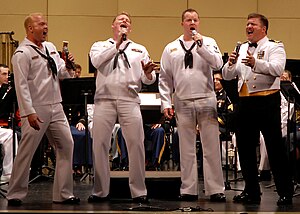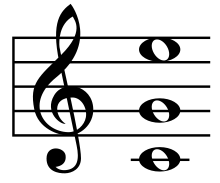Introduction

Barbershop quartets, such as this U.S. Navy group, sing 4-part pieces, made up of a melody line (normally the lead) and 3 harmony parts.When you have more than one pitch sounding at the same time in music, the result is harmony. Harmony is one of the basic elements of music, but it is not as basic as some other elements, such as rhythm and melody. You can have music that is just rhythms, with no pitches at all. You can also have music that is just a single melody, or just a melody with rhythm accompaniment.
Harmony is two or more notes played together at the same time. As soon as there is more than one pitch sounding at a time, you have harmony. Even if nobody is actually playing chords, or even if the notes are part of independent contrapuntal lines, you can hear the relationship of any notes that happen at the same time, and it is this relationship that makes the harmony.
Note: Harmony does not have to be particularly “harmonious”; it may be quite dissonant, in fact. For the purpose of definitions, the important fact is the notes sounding at the same time.
Harmony is the most emphasized and most highly developed element in Western music, and can be the subject of an entire course on music theory.
In music, harmony is the use of simultaneous pitches (tones, notes), or chords. The study of harmony involves chords and their construction and chord progressions and the principles of connection that govern them. Harmony is often said to refer to the “vertical” aspect of music, as distinguished from melodic line, or the “horizontal” aspect.
In many types of music, notably baroque, romantic, modern and jazz, chords are often augmented with “tensions”. A tension is an additional chord member that creates a relatively dissonant interval in relation to the bass. Typically, in the classical common practice period a dissonant chord (chord with tension) “resolves” to a consonant chord. Harmonization usually sounds pleasant to the ear when there is a balance between the consonant and dissonant sounds. In simple words, that occurs when there is a balance between “tense” and “relaxed” moments.
Etymology and Definitions
The term harmony derives from the Greek ἁρμονία (harmonía), meaning “joint, agreement, concord”, from the verb ἁρμόζω (harmozo), “to fit together, to join”. In Ancient Greece, the term defined the combination of contrasted elements: a higher and lower note.

Rameau’s ‘Traité de l’harmonie’ (Treatise on Harmony) from 172
The view that modern tonal harmony in Western music began in about 1600 is commonplace in music theory. This is usually accounted for by the ‘replacement’ of horizontal (of contrapuntal) writing, common in the music of the Renaissance, with a new emphasis on the ‘vertical’ element of composed music. Modern theorists, however, tend to see this as an unsatisfactory generalisation. As Carl Dahlhaus puts it,
It was not that counterpoint was supplanted by harmony (Bach’s tonal counterpoint is surely no less polyphonic than Palestrina’s modal writing) but that an older type both of counterpoint and of vertical technique was succeeded by a newer type. And harmony comprises not only the (‘vertical’) structure of chords but also their (‘horizontal’) movement. Like music as a whole, harmony is a process.
Descriptions and definitions of harmony and harmonic practice may show bias towards European (or Western) musical traditions. For example, South Asian art music (Hindustani and Carnatic music) is frequently cited as placing little emphasis on what is perceived in western practice as conventional ‘harmony’; the underlying ‘harmonic’ foundation for most South Asian music is the drone, a held open fifth (or fourth) that does not alter in pitch throughout the course of a composition.
Nevertheless, emphasis on the precomposed in European art music and the written theory surrounding it shows considerable cultural bias. The Grove Dictionary of Music and Musicians (Oxford University Press) identifies this clearly:
In Western culture the musics that are most dependent on improvisation, such as jazz, have traditionally been regarded as inferior to art music, in which pre-composition is considered paramount. The conception of musics that live in oral traditions as something composed with the use of improvisatory techniques separates them from the higher-standing works that use notation.
Yet the evolution of harmonic practice and language itself, in Western art music, is and was facilitated by this process of prior composition (which permitted the study and analysis by theorists and composers alike of individual pre-constructed works in which pitches—and to some extent rhythms—remained unchanged regardless of the nature of the performance).
Historical Rules
Some traditions of Western music performance, composition, and theory have specific rules of harmony. These rules are often described as based on natural properties such as Pythagorean tuning’s law whole number ratios (“harmoniousness” being inherent in the ratios either perceptually or in themselves) or harmonics and resonances (“harmoniousness” being inherent in the quality of sound), with the allowable pitches and harmonies gaining their beauty or simplicity from their closeness to those properties. This model provides that the minor seventh and ninth are not dissonant (i.e., are consonant). While Pythagorean ratios can provide a rough approximation of perceptual harmonicity, they cannot account for cultural factors.
Early Western religious music often features parallel perfect intervals; these intervals would preserve the clarity of the original plainsong. These works were created and performed in cathedrals, and made use of the resonant modes of their respective cathedrals to create harmonies. As polyphony developed, however, the use of parallel intervals was slowly replaced by the English style of consonance that used thirds and sixths. The English style was considered to have a sweeter sound, and was better suited to polyphony in that it offered greater linear flexibility in part-writing. Early music also forbade usage of the tritone, as its dissonance was associated with the devil, and composers often went to considerable lengths, via musica ficta, to avoid using it. In the newer triadic harmonic system, however, the tritone became permissible, as the standardization of functional dissonance made its use in dominant chords desirable.
Most harmony comes from two or more notes sounding simultaneously—but a work can imply harmony with only one melodic line by using arpeggios or hocket. Many pieces from the baroqueperiod for solo string instruments—such as Bach’s Sonatas and partitas for solo violin and cello—convey subtle harmony through inference rather than full chordal structures. These works create a sense of harmonies by using arpeggiated chords and implied basslines. The implied basslines are created with low notes of short duration that many listeners perceive as being the bass note of a chord. (See below):

Example of implied harmonies in J.S. Bach’s Cello Suite no. 1 in G, BWV 1007, bars 1-2. Play (help·info) or Play harmony (help·info)
Types

Close position C major triad.

Open position C major triad.
Close harmony and open harmony use close position and open position chords, respectively.
Other types of harmony are based upon the intervals of the chords used in that harmony. Most chords used in western music are based on “tertian” harmony, or chords built with the interval of thirds. In the chord C Major7, C-E is a major third; E-G is a minor third; and G to B is a major third. Other types of harmony consist of quartal harmony and quintal harmony.
Unison is considered a harmonic interval, just like a fifth or a third. What’s unique about unison is that it is two identical notes being played or sung together. Most people only consider thirds and fifths and sevenths to be “harmony”. But, unison does count as harmony, and is very important in orchestration, especially. In Pop music, unison singing is usually called “doubling” which is what The Beatles used to do a lot in their early music. As a type of harmony, singing in unison or playing the same notes, often using different musical instruments, at the same time is commonly called monophonic harmonization.
Candela Citations
- Understanding Basic Music Theory. Authored by: Catherine Schmidt-Jones . Provided by: OpenStax. Located at: http://cnx.org/contents/2ad74b7b-a72f-42a9-a31b-7e75542e54bd@3.74:22/Understanding_Basic_Music_Theo. License: CC BY: Attribution. License Terms: OpenStax content can be downloaded for free at cnx.org
- Harmony. Provided by: Wikipedia. Located at: http://en.wikipedia.org/wiki/Harmony. License: CC BY: Attribution